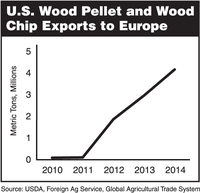Renewable Accounts: Solid Biofuels, Part One
(Click the image below to view a high-resolution image that can be downloaded)
By David Ripplinger, Bioproducts and Bioenergy Economist and Assistant Professor
NDSU Department of Agribusiness and Applied Economics
When I returned to the Department of Agribusiness and Applied Economics at North Dakota State University in 2010, I expected my research to focus on the economics of liquid biofuels. The corn-ethanol industry had expanded rapidly since the passage of the Renewable Fuel Standard (RFS). The plan was that cellulosic ethanol, although requiring more work, would be next.
The team that I joined was estimating the availability of crop residue in the region for conversion to ethanol. In other parts of the country, there was research on converting other biomass, including wood and dedicated energy crops, into liquid fuel. The biggest thing in cellulosics today is arguably keeping it in its solid form and shipping it to Europe.
In 2009, the European Commission established the Renewable Energy Directive that mandated 20 percent of energy come from renewable sources by 2020. This mandate is being achieved in large part by increasing the use of wood as a solid fuel. Most of this wood is being harvested in Europe.
However, since 2010, U.S. exports of wood pellets and chips to Europe have increased nearly 100-fold to more than 4 million metric tons a year. How much is that? Enough for Paul Bunyan to break a sweat; that’s in the ballpark of all the wood harvested annually in Minnesota.
There are two reasons why this is important to a North Dakota grain farmer. One reason is the value of straw is going up. The demand pull from Europe is impacting the global market for fiber. The supply chains pulling this material from the Southeast and Pacific Northwest are massive and using material that otherwise might have been used as fuel here.
Combined with other market forces and technological advancement, there is increased interest in the use of agricultural biomass, i.e. straw, as solid fuel. Of course, the price the market is willing to pay may not be enough for farmers to change crop residue management practices.
In February and March, I’ll be meeting with farmers in eastern North Dakota to talk about specific opportunities that exist and the costs associated with supplying crop residue.
The second reason is that renewable policies have an impact. Europe’s Renewable Energy Directive has significantly impacted the price of fiber. What happens if a similar policy is created in the U.S? To cut to the chase – that policy already may be here.
The subject of my next article is that policy, the Environmental Protection Agency’s Clean Power Plan, a policy that could have almost as large of an impact on North Dakota and crop residue as the RFS did on Iowa and corn.
NDSU Agriculture Communication - Feb. 2, 2016
| Source: | David Ripplinger, (701) 231-5265, david.ripplinger@ndsu.edu |
|---|---|
| Editor: | Kelli Armbruster, (701) 231-6136, kelli.armbruster@ndsu.edu |


